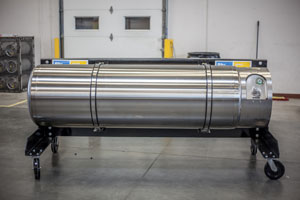Managing Editor, Features and Multimedia
Blu Launches Lower-Cost LNG Fuel Tanks for Class 8 Trucks

Natural gas-fueling supplier Blu has launched a liquefied natural gas-fueling system for Class 8 trucks aimed at lowering the cost barrier for fleets to adopt the alternative fuel.
The Blu V2 LNG Fuel Delivery System, a 160-diesel-gallon equivalent twin-tank package, has a list price of $18,000 after a $7,000 rebate for fueling at Blu’s network of 24 LNG stations across the country.
Blu said that is about 40% lower than comparable fueling systems on the market.
The company decided to expand into the vehicle fuel-tank space to help drive down the purchase price of natural gas-powered trucks, CEO Merritt Norton told Transport Topics.
“In order for natural gas to be viable in anything other than a niche market, the incremental cost of the truck has to get to a point where the average customer can get a one-year payback,” he said. “We’re not there yet, but this is a big step in that direction.”
With Blu’s new tank system, the average fleet owner will see a return on investment within two years, compared with a three- to five-year period for current tank systems, Norton said.
The Blu V2 system, scheduled to begin shipping next month, is available for natural gas-powered trucks from Peterbilt, Kenworth, Volvo, Mack and Freightliner, the company said.
The tank systems are available in a variety of configurations to meet fleets’ different needs, including 80 DGE and 68 DGE tank sizes, and come with a two-year, 200,000-mile warranty.
Although Blu’s new system is designed for LNG-powered trucks, many of the fleets adopting natural gas are investing in compressed natural gas instead.
Earlier this month, ACT Research founder Ken Vieth estimated that upward of 90% of incoming orders for natural-gas trucks are for vehicles powered by CNG, which is less expensive than LNG.
However, Norton said he expects the higher cost and weight of CNG-powered trucks will convince many fleets to look to LNG.
An LNG truck is about $20,000 to $30,000 less expensive, he said, and 1,000 to 1,500 pounds lighter than a comparable CNG truck with fuel onboard.
Since LNG is a low-pressure, liquid fuel, manufacturers can build tanks that weigh less and cost less to make than CNG tanks, which must contain high-pressure gas, he said.
Blu, based in Salt Lake City, is launching the LNG fueling system at a time when engine options remain limited for the North American trucking market.
Cummins Westport last year introduced the spark-ignited 11.9-liter ISX12 G, which serves the needs of many trucking operations but may not be adequate for applications requiring high horsepower.
Cummins has paused development on a 15-liter natural-gas engine, and Volvo Trucks has put its planned 13-liter LNG engine on hold.
Norton said the lack of a larger natural-gas engine “is an issue” for the industry but pointed to the high cost of natural-gas trucks as the biggest problem.
Today, truck buyers are paying significantly more for a natural-gas engine than a diesel powerplant, but that price differential could disappear as higher demand leading to higher volumes and competition heats up, he said.
In fact, spark-ignited natural-gas engines eventually could become less expensive than diesel engines because they don’t require selective catalytic reduction technology to comply with federal emission standards, Norton said.
“When you look at the long-term future of natural gas, there’s every reason to believe that natural-gas engines in the next five years will be less costly than diesel engines,” he said.

